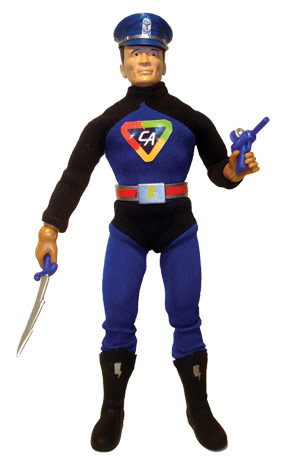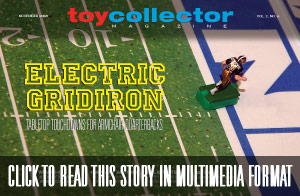
Joe Ahearn first became aware of Ideal Toys’ Captain Action in 1967 when he was 5 years old while visiting an older cousin. Ed Catto simply credits Santa Claus for his introduction to the character the same year. Little did either of them know that some 40 years later that they would find themselves in charge of Captain Action’s destiny.
The character debuted in 1966 into a climate that in hindsight seems almost made for it. G.I. Joe was the top action figure for boys. The Batman TV show was just igniting Batmania and the wave of superheroes that followed him from the printed page to the worlds of cartoons, movies and merchandising.
In the world of dolls and action figures, Barbie had been the first to successfully seize upon the “razor/razorblade” concept that today is seen as the “hardware/software” mix – sell the customer the hardware, such as a DVD player or iPod at a relatively inexpensive price, and the consumer will keep purchasing the DVDs or downloads of music in perpetuity. With Barbie, and then G.I. Joe, new costumes – the latest fashions or specialty military uniforms, respectively – were the razorblades or software. Kids always wanted the latest ones, and Mattel and Hasbro reaped the benefits.
“In 1965, the Ideal Toy Corporation, producers of a plethora of playthings including King Zor the Dinosaur, the walking robot Mr. Machine, the Betsy Wetsy doll, Motorific miniature racing cars and the interactive Mouse Trap board game, elected to directly challenge, rather than imitate, Hasbro’s dominance of the action figure market,” author and historian Michael Eury wrote in Captain Action: The Original Super-Hero Action Figure, widely considered to be the definitive work on the original incarnation of the toy line.
The company brought in Stan Weston, who had worked with Larry Reiner and the legendary Don Levine on G.I. Joe for Hasbro, and who would later go on to develop the Mego action figure line in the 1970s. The result was almost called “Captain Magic.” Though the name was shelved, the idea that the character would change identities did not. The company licensed numerous other characters for the newly christened Captain Action to impersonate.
Instead of simply putting on a new outfit like Barbie or new uniform like G.I. Joe, Captain Action would more or less become a string of highly recognizable other characters. Superman, Aquaman, Steve Canyon, the Lone Ranger, Flash Gordon, Captain America, Batman, Sgt. Fury, the Phantom and others were all on tap.
Veteran DC Comics artist Murphy Anderson, then as now one of the most respected craftsman in the trade, was drafted to illustrate the packaging, further cementing the relation between the new toy and the characters for whom he would pass.
Captain Action was released to the public in 1966 and got an almost immediate shot in the arm from the Batman TV show. Costumes for Spider-Man, Buck Rogers, Green Hornet, and Tonto were part of the line.
In 1967, Captain Action got a sidekick, Action Boy, who was featured with costumes for Aqualad, Superboy and Robin. A year later, Dr. Evil, “the sinister invader of Earth,” showed up to menace the good captain.
In addition to the costumes, there were also accessory packs that featured equipment and weapons such as the Inter-Spacial Directional Communicator, Anit-Gravitational Power Pack, the 10-Piece Weapons Arsenal, Inter-Galactic Jet Mortar and so on. There were vehicles and play sets, and there were also Halloween costumes and a handful of other licensed products. One of the projects was a Captain Action comic book from DC Comics. It featured stories by writer Jim Shooter, who later became editor-in-chief of Marvel Comics, and Gil Kane, who also served as artist for several issues. By the time Captain Action #5 came out in 1969, though, it was an afterthought. The Captain Action toy line from Ideal was no more.
But that’s not how it works in superhero stories or with intellectual properties. Fans of the character didn’t give up so easily.
In 1987, A.C.T.I.O.N. Force #1, featuring Captain Action and a group of other heroes, was published by Lightning Comics. That was the only issue, but it marked the first time the hero had reappeared. Two years later, Jim Main, who had written A.C.T.I.O.N. Force #1, ran stories featuring the character in three issues of Toy Collectors’ Journal.
Captain Action #0, produced by Karl Art Publishing in 1995, was another one-and-done attempt to revive the property, but still Captain Action would not entirely fade away. Just three years later, he’d be back in the toy business.
Playing Mantis launched a line of Captain Action reissues in 1998. That line was spearheaded by a freelance product consultant and nearly life-long Captain Action enthusiast named Joe Ahearn.
“They produced the Captain Action and Dr. Evil dolls, along with costumes for Green Hornet, Kato, Flash Gordon and Ming,” said author, historian and pioneering auction house founder Ted Hake. “Later, they entered into an exclusive deal with Diamond Select Toys, and recently produced the Lone Ranger costume and the Kid Action doll.”
While the Playing Mantis incarnation, which included the introduction of the redubbed Kid Action, lasted until only 2000, Ahern’s passion for the character meant that he wasn’t giving up so easily.
As a child, he had drifted away from Captain Action around age 11, he said, but he always had retained a soft spot for the identity-changing hero. He reconnected with Captain Action in the mid 1990s when he began re-collecting both Cap and GI Joe items to supplement what he had left from his childhood collection. After his involvement with Playing Mantis, he kept collecting, including one really big prize: he successfully acquired the trademark to Captain Action.
He decided to team up with Ed Catto, a friend from the Yahoo Captain Action collectors group, because of their shared great love of the character and what Ahearn described as Catto’s “great business sense as a marketing professional.” Together in 2005 they formed Captain Action Enterprises LLC.
For his part, Catto said that he had drifted away from the character about the time he discovered the appeal of young ladies, but when he returned to the character that old energy just grabbed him again.
“I remember the nostalgic zing so vividly, but that was almost 20 years ago, too,” he said. Like Ahearn, he started collecting Captain Action again and networking with fellow enthusiasts.
Later, when they teamed up, the two of them did not want to just bring Captain Action back as a retro experience or simply as an action figure. Instead, they quickly formulated a plan to develop the character into a multimedia property.
Their first step was into the world of comic books, where they partnered with Moonstone Books, known for producing The Phantom and Kolchak The Night Stalker, among other series. Written by industry veteran Fabian Nicieza and illustrated by Mark Sparacio, Captain Action #0 introduced a revised version of the 1960s hero of a thousand faces and established a new back story. Different than both the action figure and the DC Comics versions, the new title is nonetheless filled with nods to the originals.
It was merely the first piece of the puzzle.
They almost instantly sold out of a reproduction version of the original Aurora model kit they did with Moebius Models in April. They have released a pair of Mego-style action figures (unlike the original 12-inch figures, these are shorter, like the original Mego figures) with Cast-a-way Toys, a statue produced by Electric Tiki and released through Sideshow Collectibles, a novella, prints and other items. They’ll also be launching a prose anthology of Captain Action adventures, and a new character, Lady Action, into her own series in the coming months. Through Café Press, they offer T-shirts, baseball caps, coffee mugs, keepsake boxes and messenger bags.
“We’ve had a lot of requests for the Captain Action hat,” Catto said of the character’s signature cap, “so we’re going to be making them available as well.”
“Our kickoff at the New York Comic-Con really opened a lot of doors for us,” Catto said. “We have been approached by many noted writers and artists who want to be involved.”
Those creators included Murphy Anderson, the artist who designed the original packaging for Ideal. He has illustrated a variant cover for the group and may do more with them. Ironically, for someone noted as a major force in comic book art – particularly at DC Comics – for decades, he never did any illustration work for the captain’s comic book adventures before.
Catto said that journey from child playing with Captain Action in to adult playing with him in an entirely different way has been amazing, and that the ability to work with people like Anderson was simultaneously exciting and humbling.
Ahearn agreed, and both of them are still collecting.
Click here to search LiveAuctioneers.com for Captain Action.
CAPTAIN ACTION MULTIMEDIA: click any image
{rokbox album=|captainaction| title=|Ideal Captain Action, 1966 :: The first Captain Action in its original box, a prize among collectors, was released in 1966 by Ideal. Boxed and with its accessories, it can sell for more than $1,000. Image courtesy of Geppi’s Entertainment.|}images/stories/2008_11/2008_11_tcm_ca_01.jpg{/rokbox} {rokbox album=|captainaction| title=|Captain America Costume, 1966 :: Released in 1966, the Captain America costume for Captain Action can bring prices in the $1,500 range with its box and accessories. Image courtesy of Geppi’s Entertainment.|}images/stories/2008_11/2008_11_tcm_ca_02.jpg{/rokbox} {rokbox album=|captainaction| title=|Dr. Evil :: Normally fetching $100 or more over the price for Captain Action, Dr. Evil is widely considered one of the most sought-after figures from the Captain Action line. A rare second edition boxed set, which includes his disguises, sells for $3,000. Image courtesy of Geppi’s Entertainment.|}images/stories/2008_11/2008_11_tcm_ca_03.jpg{/rokbox} {rokbox album=|captainaction| title=|Green Hornet Costume, 1967 :: Offered in 1967, today the Green Hornet costume, in the box and with accessories, can sell for $4,000 or more. Image courtesy Geppi’s Entertainment.|}images/stories/2008_11/2008_11_tcm_ca_04.jpg{/rokbox} {rokbox album=|captainaction| title=|Captain Action DC Comic, 1968 :: DC Comics released the first issue of Captain Action, written by Jim Shooter and illustrated by Wally Wood, in late 1968. Image courtesy Geppi’s Entertainment.|}images/stories/2008_11/2008_11_tcm_ca_05.jpg{/rokbox}


